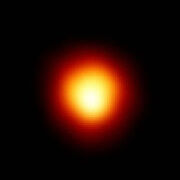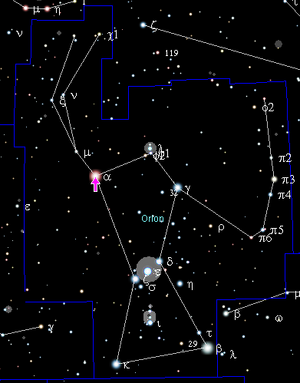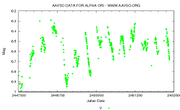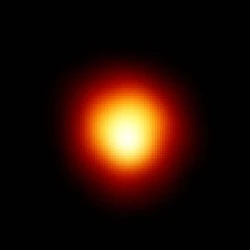No edit summary |
|||
| (14 intermediate revisions by 11 users not shown) | |||
| Line 14: | Line 14: | ||
}} |
}} |
||
{{Starbox character |
{{Starbox character |
||
| − | | class = M2Iab |
+ | | class = M2Iab (red supergiant) |
| b-v = 1.86 |
| b-v = 1.86 |
||
| u-b = 2.06 |
| u-b = 2.06 |
||
| Line 43: | Line 43: | ||
{{Starbox end}} |
{{Starbox end}} |
||
| − | '''Betelgeuse''' ( |
+ | '''Betelgeuse''' ([ˈbiːtəldʒuːz], [ˈbɛtəldʒuːz] or [ˈbiːtəldʒuːs]; α Orionis, α Ori, Alpha Orionis) is a [[semiregular variable star]] located 427 [[light-year]]s away [http://simbad.u-[[File:200px-Betelgeuse_star_(Hubble).jpg|thumb]]strasbg.fr/cgi-bin/cdsbib?1997A%26A...323L..49P]. It is the second brightest [[star]] in the [[constellation]] Orion [and the ninth [[list of brightest stars|brightest star]] in the night sky. Although it has the [[Bayer designation]] "alpha", it is not as bright as [[Rigel]] (Beta Orionis). It is a [[vertex]] of the [[Winter Triangle]] asterism. ;] |
Betelgeuse is a [[red supergiant]], one of the physically [[List of largest known stars|largest stars]] known. If it were placed at the center of our [[solar system]], its outer surface would possibly extend to the orbit of Jupiter. As it is, Betelgeuse is so large and so close that it is the star with the third largest [[angular diameter]] as viewed from Earth [http://iapetus.phy.umist.ac.uk/rdor/rdor.html], smaller only than the Sun and [[R Doradus]], and one of only a dozen or so stars that telescopes have imaged as a visible disk (See photo, at right and a [http://www.mrao.cam.ac.uk/telescopes/coast/betel.html picture of hotspots] on Betelgeuse.) The angular diameter of Betelgeuse was first measured in 1920–1921 by [[Albert Abraham Michelson|Michelson]] and [[Francis G. Pease|Pease]] using an [[astronomical interferometer]] on the [[Mount Wilson Observatory|Mount Wilson]] 100 inch [[telescope]]. |
Betelgeuse is a [[red supergiant]], one of the physically [[List of largest known stars|largest stars]] known. If it were placed at the center of our [[solar system]], its outer surface would possibly extend to the orbit of Jupiter. As it is, Betelgeuse is so large and so close that it is the star with the third largest [[angular diameter]] as viewed from Earth [http://iapetus.phy.umist.ac.uk/rdor/rdor.html], smaller only than the Sun and [[R Doradus]], and one of only a dozen or so stars that telescopes have imaged as a visible disk (See photo, at right and a [http://www.mrao.cam.ac.uk/telescopes/coast/betel.html picture of hotspots] on Betelgeuse.) The angular diameter of Betelgeuse was first measured in 1920–1921 by [[Albert Abraham Michelson|Michelson]] and [[Francis G. Pease|Pease]] using an [[astronomical interferometer]] on the [[Mount Wilson Observatory|Mount Wilson]] 100 inch [[telescope]]. |
||
| Line 73: | Line 73: | ||
==The star's future== |
==The star's future== |
||
| − | Astronomers predict that Betelgeuse will ultimately undergo a type II [[supernova]] explosion although it is possible that the mass is low enough for Betelgeuse to leave a rare oxygen-neon [[white dwarf]]. |
+ | Astronomers predict that Betelgeuse will ultimately undergo a type II [[supernova]] explosion although it is possible that the mass is low enough for Betelgeuse to leave a rare oxygen-neon [[white dwarf]]. Opinions are divided as to the likely timescale for this event. Although Betelgeuse is only around six million years old,<ref>http://www.solstation.com/x-objects/betelgeuse.htm</ref> some regard the star's current variability as suggesting that it is already in the [[carbon]] burning phase of its life cycle, and will therefore undergo a supernova explosion at somme time in the next thousand years or so. Skeptics dispute this contention and regard the star as being likely to survive much longer. |
There is a consensus that such a supernova would be a spectacular astronomical event, but would not — being so distant — represent any significant threat to life on Earth. |
There is a consensus that such a supernova would be a spectacular astronomical event, but would not — being so distant — represent any significant threat to life on Earth. |
||
| − | Even so, Betelgeuse would brighten at least 10,000 times as a supernova, causing it to shine with the luminosity of a crescent Moon. Some sources predict a maximum apparent magnitude equal to about that of the full Moon (mv = -12.5). This would likely last for several months. It would look like a brilliant point, the brightness of a full Moon with the color of an incandescent bulb at night, and easily visible in daylight. After that period it would gradually diminish until after some months or years it would disappear from naked eye view. |
+ | Even so, Betelgeuse would brighten at least 10,000 times as a supernova, causing it to shine with the luminosity of a crescent Moon. Some sources predict a maximum apparent magnitude equal to about that of the full Moon (mv = -12.5). This would likely last for several months. It would look like a brilliant point, the brightness of a full Moon with the color of an incandescent bulb at night, and easily visible in daylight. After that period it would gradually diminish until after some months or years it would disappear from naked eye view. Then Orion's right shoulder would vanish for a time until, in a few centuries, a splendid [[nebula]] would develop. Its original name was miller if Betelgeuse's axis (one of its poles) is pointed towards Earth there would be tangible effects here. A shower of gamma rays and other cosmic particles would be directed at Earth. There would be spectacular [[Aurora (phenomenon)|aurorae]] and possibly a measurable diminution of the [[ozone layer]] with consequent adverse radiation effects on life. In such an orientation towards the [[solar system]] it would also appear many times brighter than if its axis were pointed away. |
| − | Curiously, 1st century BC Chinese records unearthed by Shu-ren, Jianmin and Jin-Yi in [[1980]] refer to the color of Betelgeuse as being white or yellow. |
+ | Curiously, 1st century BC Chinese records unearthed by Shu-ren, Jianmin and Jin-Yi in [[1980]] refer to the color of Betelgeuse as being white or yellow. However, Ptolemy writing in 150 AD calls it a red star. Therefore, [[Fang Lizhi]], a Chinese astrophysicist, proposed that Betelgeuse could have turned into a red giant star during that period. It is known that as stars use up the hydrogen fuel in their cores, their color changes from white to yellow to red. Shu-ren et al. suggest that Betelgeuse could have changed its color when it expelled a shell of dust and gas, that, even now, can be seen to be expanding away from it. Thus, if their theory is right, it is unlikely that Betelgeuse will become a supernova any time soon because a star usually stays a red giant for tens of thousands of years. but anything can happen at any time. |
[[Image: 68029.png |thumb|| right| [[AAVSO]] [[Photometric system|V-band]] [[light curve]] of Betelgeuse, (a.k.a Alpha Orionis) from Dec. 1988 - Aug. 2002 ]] |
[[Image: 68029.png |thumb|| right| [[AAVSO]] [[Photometric system|V-band]] [[light curve]] of Betelgeuse, (a.k.a Alpha Orionis) from Dec. 1988 - Aug. 2002 ]] |
||
| Line 86: | Line 86: | ||
* Li-Zhi, Fang, Chinese Astronomy and Astrophysics (an English journal), 1981 or 1982 |
* Li-Zhi, Fang, Chinese Astronomy and Astrophysics (an English journal), 1981 or 1982 |
||
* "When did it change to red?", The Hindu (a popular English language newspaper in India), Sunday Supplement, January 31-1982. |
* "When did it change to red?", The Hindu (a popular English language newspaper in India), Sunday Supplement, January 31-1982. |
||
| − | * {{cite web | last = Davis | first = Kate | date = 2000-12-01 | url = http://www.aavso.org/vstar/vsots/1200.shtml | title = Variable Star of the Month—December, 2000: Alpha Orionis | publisher = AAVSO | language = English | accessdate = 2006-08-13 }} |
+ | * {{cite web | last = Davis | first = Kate | date = 2000-12-01 | url = http://www.aavso.org/vstar/vsots/1200.shtml | title = Variable Star of the Month—December, 2000: Alpha Orionis | publisher = AAVSO | language = English | accessdate = 2006-08-13 |archiveurl=http://web.archive.org/web/20030705130559/http://www.aavso.org/vstar/vsots/1200.shtml|archivedate=2003-07-05}} |
*[http://uk.arxiv.org/pdf/astro-ph/0402099 Interferometric observations of the supergiant stars α Orionis and α Herculis with FLUOR at IOTA], February 2004 |
*[http://uk.arxiv.org/pdf/astro-ph/0402099 Interferometric observations of the supergiant stars α Orionis and α Herculis with FLUOR at IOTA], February 2004 |
||
| Line 101: | Line 101: | ||
accessmonthday=11 November | |
accessmonthday=11 November | |
||
accessyear=2005}} |
accessyear=2005}} |
||
| − | |||
[[Category:Bayer objects|Orionis, Alpha]] |
[[Category:Bayer objects|Orionis, Alpha]] |
||
[[Category:Orion constellation]] |
[[Category:Orion constellation]] |
||
[[Category:Red giants]] |
[[Category:Red giants]] |
||
[[Category:Red supergiants]] |
[[Category:Red supergiants]] |
||
| − | [[Category: |
+ | [[Category:Stars]] |
[[Category:Arabic words and phrases]] |
[[Category:Arabic words and phrases]] |
||
Latest revision as of 02:02, 3 July 2018
| Observation data Epoch J2000.0 | |
|---|---|
| Constellation | Orion |
| Right ascension | 05h 55m 10.3s |
| Declination | +07° 24′ 25″ |
| Apparent magnitude (V) | +0.3 to +1.2 |
| Characteristics | |
| Spectral type | M2Iab (red supergiant) |
| B-V color index | 1.86 |
| U-B color index | 2.06 |
| Variable type | SR c (Semi-regular) |
| Astrometry | |
| Radial velocity (Rv) | +21.0 km/s |
| Proper motion (μ) | RA: 27.33 mas/yr Dec.: 10.86 mas/yr |
| Parallax (π) | 7.63 ± 1.64 mas |
| Distance | approx. Expression error: Unrecognized punctuation character "[". ly (approx. Expression error: Unrecognized punctuation character "[". pc) |
| Absolute magnitude (MV) | −5.14 |
| Details | |
| Mass | 15 M☉ |
| Radius | 650 R☉ |
| Luminosity | 40,000–100,000 (bolometric) L☉ |
| Temperature | 3,600 K |
| Metallicity | |
| Rotation | |
| Age | 6 × 106 years |
| Other designations | |
Alpha Orionis, 58 Ori, HR 2061, BD+7°1055, HD 39801, SAO 113271, FK5 224, HIP 27989
| |
| Database references | |
| SIMBAD | data
|
Betelgeuse ([ˈbiːtəldʒuːz], [ˈbɛtəldʒuːz] or [ˈbiːtəldʒuːs]; α Orionis, α Ori, Alpha Orionis) is a semiregular variable star located 427 light-years away

strasbg.fr/cgi-bin/cdsbib?1997A%26A...323L..49P. It is the second brightest star in the constellation Orion [and the ninth brightest star in the night sky. Although it has the Bayer designation "alpha", it is not as bright as Rigel (Beta Orionis). It is a vertex of the Winter Triangle asterism. ;]
Betelgeuse is a red supergiant, one of the physically largest stars known. If it were placed at the center of our solar system, its outer surface would possibly extend to the orbit of Jupiter. As it is, Betelgeuse is so large and so close that it is the star with the third largest angular diameter as viewed from Earth [1], smaller only than the Sun and R Doradus, and one of only a dozen or so stars that telescopes have imaged as a visible disk (See photo, at right and a picture of hotspots on Betelgeuse.) The angular diameter of Betelgeuse was first measured in 1920–1921 by Michelson and Pease using an astronomical interferometer on the Mount Wilson 100 inch telescope.
Origin of the name "Betelgeuse"
The name is a corruption of the Arabic يد الجوزا yad al-jawzā, or "hand of the central one". Jauza, the central one, initially referred to Gemini among the Arabs, but later referred to Orion instead. During the Middle Ages the first character of the name, y (ﻴ, with two dots under it), was misread as a b (ﺒ, with one dot under it) when transliterating into Latin, and Yad al-Jauza became Bedalgeuze. Then, during the Renaissance, it was theorized that the name was originally written as Bait al-Jauza, thought to mean "armpit of the central one" in Arabic, which led to the modern rendering as "Betelgeuse"; however, the actual translation of "armpit" would be ابط ("Ibţ").
Because of its rich reddish color the star has frequently been referred to as the "martial one", and in astrology portends military or civic honors. Other names are:
- Al Dhira (the Arm),
- Al Mankib (the Shoulder)
- Al Yad al Yamma (the Right Hand)
- Ardra (Hindi, and name of Hindu Nakshatra),
- Bahu (Sanskrit),
- Besn (Persian) (the Arm),
- Gula (Euphratean),
- Ied Algeuze (Orion's Hand),
- Klaria (Coptic) (an Armlet)
- Yedelgeuse
It is known as 参宿四 (Shēnsùsì, the Fourth Star of the Constellation of Three Stars) in Chinese. The confusing name is due to the fact that the Constellation of Three Stars was originally composed of just three stars, all of them in the girdle of the Orion. Later, four more stars were added to this constellation, but the name remained unchanged.
Distinguishing characteristics
Several features of Betelgeuse are of particular interest to astronomers. It was one of the first stars to have its angular diameter measured with an astronomical interferometer; the apparent diameter was found to be variable. The distance to Betelgeuse is not precisely known, but if it is assumed to be 427 light years then the actual diameter varies between 500 and 800 times the Sun's diameter, making it roughly equivalent to the orbit of Jupiter. It has a color index (B-V) of 1.86 and is thought to have a mass of about 15 solar masses.
The precise diameter is not easy to define, as the optical emission decreases very gradually with radius from the center of the star, and the color of the emission also varies with radius. Though only 15 times more massive than the Sun, it is as much as 300 million times greater in volume; a difference in volume much like a beach ball compared to a large stadium. It was also the first star to have starspots on its disk resolved in optical images by a telescope, first from Aperture Masking Interferometry and later from more detailed observations by the COAST telescope.

Betelgeuse (↑) in Orion
The star's future
Astronomers predict that Betelgeuse will ultimately undergo a type II supernova explosion although it is possible that the mass is low enough for Betelgeuse to leave a rare oxygen-neon white dwarf. Opinions are divided as to the likely timescale for this event. Although Betelgeuse is only around six million years old,[1] some regard the star's current variability as suggesting that it is already in the carbon burning phase of its life cycle, and will therefore undergo a supernova explosion at somme time in the next thousand years or so. Skeptics dispute this contention and regard the star as being likely to survive much longer. There is a consensus that such a supernova would be a spectacular astronomical event, but would not — being so distant — represent any significant threat to life on Earth.
Even so, Betelgeuse would brighten at least 10,000 times as a supernova, causing it to shine with the luminosity of a crescent Moon. Some sources predict a maximum apparent magnitude equal to about that of the full Moon (mv = -12.5). This would likely last for several months. It would look like a brilliant point, the brightness of a full Moon with the color of an incandescent bulb at night, and easily visible in daylight. After that period it would gradually diminish until after some months or years it would disappear from naked eye view. Then Orion's right shoulder would vanish for a time until, in a few centuries, a splendid nebula would develop. Its original name was miller if Betelgeuse's axis (one of its poles) is pointed towards Earth there would be tangible effects here. A shower of gamma rays and other cosmic particles would be directed at Earth. There would be spectacular aurorae and possibly a measurable diminution of the ozone layer with consequent adverse radiation effects on life. In such an orientation towards the solar system it would also appear many times brighter than if its axis were pointed away.
Curiously, 1st century BC Chinese records unearthed by Shu-ren, Jianmin and Jin-Yi in 1980 refer to the color of Betelgeuse as being white or yellow. However, Ptolemy writing in 150 AD calls it a red star. Therefore, Fang Lizhi, a Chinese astrophysicist, proposed that Betelgeuse could have turned into a red giant star during that period. It is known that as stars use up the hydrogen fuel in their cores, their color changes from white to yellow to red. Shu-ren et al. suggest that Betelgeuse could have changed its color when it expelled a shell of dust and gas, that, even now, can be seen to be expanding away from it. Thus, if their theory is right, it is unlikely that Betelgeuse will become a supernova any time soon because a star usually stays a red giant for tens of thousands of years. but anything can happen at any time.

AAVSO V-band light curve of Betelgeuse, (a.k.a Alpha Orionis) from Dec. 1988 - Aug. 2002
References
- Peter G. Tuthill, Chris A. Haniff, John E. Baldwin, Hotspots on late-type supergiants, Monthly Notices of the Royal Astronomical Society, Volume 285, Issue 3, pp. 529-539 (1997).
- Li-Zhi, Fang, Chinese Astronomy and Astrophysics (an English journal), 1981 or 1982
- "When did it change to red?", The Hindu (a popular English language newspaper in India), Sunday Supplement, January 31-1982.
- Davis, Kate (2000-12-01). Variable Star of the Month—December, 2000: Alpha Orionis (in English). AAVSO. Archived from the original on 2003-07-05. Retrieved on 2006-08-13.
- Interferometric observations of the supergiant stars α Orionis and α Herculis with FLUOR at IOTA, February 2004
See also
External links
- Template:Note Images of hotspots on the surface of Betelgeuse taken at visible and infra-red wavelengths using high resolution ground-based interferometers.
- SIMBAD Query Result for Betelgeuse. SIMBAD international database. Retrieved on 4 April, 2005.
- Betelgeuse. SolStation. Retrieved on 11 November, 2005.
